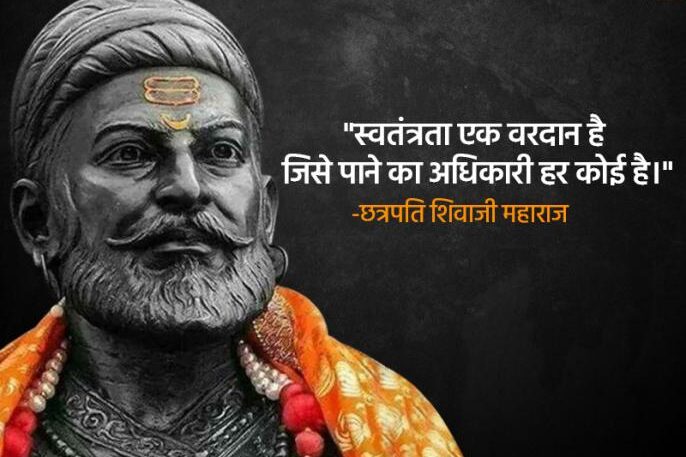
Chhatrapti Shivaji Maharaj Histry
Shivaji Maharaj is one of the great national heroes of India. He created an independent and sovereign state in Maharashtra which was based on justice, welfare of the people and tolerance to all faiths. The aims, objectives and Rajnitee of the Maratha Swaraj under Chhatrapati Shivaji provided a new direction to contemporary politics of India. In course of time, his movement assumed, the form of an all-India struggle; a struggle which was to change the political map of India.
Shivaji Maharaj was born at the Shivneri fort near Junnar in Pune district on 19th February 1630. Shivaji’s mother, Jijabai was the daughter of Lakhuji Jadhavrao of Sindkhed. His father Shahajiraje Bhosale was a prominent sardar in the Deccan. At the time of Shivaji Maharaj’s birth, most of the territory in Maharashtra was under the possession of the Nizamshah of Ahmednagar and the Adilshah of Bijapur. In the coastal belt of Konkan there were two sea powers, the Portuguese and the Siddi. The British and the Dutch who were engaged in expanding their trade also had their factories on the coast. The Mughals, since the period of Emperor Akbar 1 wanted to expand their power in the South. The Mughals launched a campaign to conquer the Nizamshahi Kingdom. The Adilshah of Bijapur allied with the Mughals in this campaign. Shahahajiraje tried to save the Nizamshahi, but he could not withstand the combined might of the Mughals and the Adilshahi. The Nizamshahi kingdom came to an end in A.D. 1636. Thereafter Shahajiraje became a sardar of the Adilshah of Bijapur and was posted in Karnataka. The region comprising Pune, Supe, Indapur and Chakan parganas located between the Bhima and Nira rivers which was vested in Shahajiraje as a jagir was continued by the Adilshah. Shahaijiraje was also assigned a jagir of Banglore. Veermata Jijabai and Shivajiraje, stayed for a few years with Shahajiraje at Banglore till Shivajiraje was twelve years old. Shahajiraje entrusted the administration of the Pune jagir to Shivajiraje and Veermata Jijabai. Shivajiraje grew up amidst the hills and valleys of Pune region under the guidance of his mother Jijabai.

Foundation of Swaraj
A number of small spurs run eastward from the sahyadris in the Pune region. The extremely rugged valleys enclosed by these are usually known as the Mavals or Khores each named after stream running through it, or after the principal village. Collectively they are known as the Mavals. The inhabitants of this region who are called the Mavalas, were an extremely hardy people. Shivaji Maharaj started the work of founding the Swaraj in this region which is full of hills and valleys and is not easily accessible. He skillfully utilized the geographical features of Maval region for the purpose of the foundation of the Swaraj. He created a feeling of trust and affection in minds of the people. Many associates, companions and Mavalas joined him in his work of founding Swaraj. The objective of Shivaji Maharaj in founding the Swaraj is clearly expressed in his official seal or Mudra which is in Sanskrit. Through this Mudra, Shivaji Maharaj assured his people that the ‘ever-increasing like the crescent-moon, the kingdom of Shivaji, son of Shahaji, will always seek the welfare of the people’
.

The Royal Seal of Shivaji Maharaj
In the medieval period, forts carried much significance. With a firm hold over a fort, one could defend as well as control the surrounding area and could rule the land. In case of an enemy’s invasion, it was possible to protect the people taking shelter in the fort. The forts situated within the jagir of Shivaji Maharaj were not under his control, but were under the control of Adilshah.. Therefore an attempt to capture the forts meant to challenge the Adilshahi power. Shivaji Maharaj decided to acquire the forts that were within his own jagir. He captured the forts of Murumbdev (Rajgad), Torna, Kondhana, Purandar and laid the foundation of the Swaraj. Shivaji Maharaj was steadily but cautiously aiming at extending and consolidating his power. Those sardars who appreciated his aim were brought to his side, but some sardars in the Adilshahi opposed him. It was necessary to bring them under control for the purpose of founding the Swaraj.
The Capture of Javali
The region of Javali in Satara district was important from strategic point of view. Many routes to the Konkan were through Javali. For the expansion of the Swaraj in the Konkan, it was essential to control that region. The region of Javali was ruled by Chandrarao More, a powerful sardar in the Adilshahi. Shivaji Maharaj attacked Javali and captured it in A.D. 1656. Then he also captured Rairi. This strong fort, later under the name of Raigad, was to become the capital of Shivaji Maharaj. Shivaji Maharaj built the Pratapgad fort in the Javali valley to protect the newly conquered territory and to control the Paar pass. The victory at Javali led to the expansion of the Swaraj in Konkan. Shivaji Maharaj then crossed the Ghats and descended into Konkan. He captured Kalyan and Bhivandi on the Konkan coast which were under the control of Adilshahi. Shivaji Maharaj also captured forts like Mahuli, Lohagad, Tunga, Tikona, Visapur, Songad, Karnala, Tala and Ghosala, in the Konkan. Shivaji Maharaj was able to command the coast line because of his acquisition of this territory in the Konkan. He came in contact with the Portuguese, the British and the Siddi powers on the western coast. The Siddi controlled the fort of Janjira and the areas around, including Danda-Rajpuri. Wherever in future these powers created obstacles in the work of expanding the Swaraj, Shivaji Maharaj tried to curb their activities.

The Establishment of Maratha Navy
When Shivaji Maharaj became master of a long coastal strip, he deemed it necessary to undertake the construction of a Navy. Shivaji Maharaj realized that the one who had a navy, controlled the sea. To protect his own territory from the Siddi’s depredations, to protect the merchant ships and ports in order to secure and enhance revenue incomes derived from maritime trade and customs duty, he concentrated on building the Navy. There were four hundred ships of various kinds in the Navy. They included battleships like Gurab, Galbat and Pal.
The Expedition of Siddi Jauhar
Shivaji Maharaj intended to capture as much of Adilshahi province and forts as possible. Thereafter, he captured from the Adilshah forts of Panhala, Vasantgad and Khelna. He renamed Khelna as Vishalgad. In A.D. 1660, to check the rapid progress of Shivaji Maharaj, the Adilshah sent Siddi Jauhar, the Sardar of Karnul region, with a large army against Shivaji Maharaj. The Adilshah gave Siddi the title of ‘Salabatkhan’. In these circumstances, Shivaji Maharaj took shelter in Panhala fort. Siddi’s soldiers led siege to the fort for about five months. Shivaji Maharaj found himself trapped inside the fort. Netoji Palkar made attempts to raise the siege by 4 attacking Siddi’s army from outside. But Siddi showed no signs of relenting. Shivaji Maharaj opened overtures with him. This led to slackness in the siege round Panhalgad. Taking advantage of the situation Shivaji Maharaj escaped through siege round the Panhala fort and proceeded to Vishalgad. Siddi Jauhar’s army pursued Shivaji Maharaj. Shivaji Maharaj stationed Baji Prabhu Deshpande at the foot of Vishalgad and entrusted the responsibility of stopping the Siddi’s army. Baji Parabhu Deshpande checked Siddi’s army at the Ghod pass near Gajapur. He fought with the greatest valour. Baji Prabhu died a hero’s death in this battle. While going to Vishalgad, Shivaji Maharaj also crushed the opposition of the Adilshahi sardars- Dalvi of Palwan and Surve of Shringarpur. Maharaj reached Vishalgad safely. While Shivaji Maharaj was trapped at Panhala, the Mughal army invaded the Swaraj. Shivaji Maharaj realized that it would not be prudent to fight two enemies at the same time. Therefore Shivaji Maharaj entered into a treaty with the Adilshah. As per the treaty, he returned the fort of Panhala to the Adilshah.

Conflict with the Mughals: Shaista Khan’s Invasion
For expansion of the Swaraj, conflict with the Mughals was inevitable. Emperor Aurangzeb appointed Shaista khan, to the viceroyalty of the Deccan, ordering him to invade and annex Shivaji Maharaj’s dominions. Shaista khan left Ahmednagar in February 1660 and arrived in Pune on 10th May 1660. He decided to capture the fort of Chakan to obtain supplies. Though the killedar of the fort of Chakan- Firangoji Narsala offered a strong resistance to Shaista khan’s army, the Mughals captured the fort of Chakan. Shaista khan captured Swaraj’s territories -Pune, Supe. He set up his camp at Lal Mahal in Pune. The Mughal army began to ravage the regions around Pune. Shaista khan adopted the strategy to occupy as much of Shivaji Maharaj’s dominions as possible. Forces were dispatched to invade the Konkan region below the Ghats. Kalyan and Bhiwandi were captured by the Mughal army. Shaista Khan appointed Kartalabkhan on an expedition to the North Konkan. Shivaji Maharaj humbled the Khan in Umbarkhind. Shivaji Maharaj left Netoji Palkar to defend the North Konkan and he himself marched southwards and captured Dabhol, Chiplun, Sangameshwar, Rajapur, Palavani and Shringarpur. Two years had passed but Shaista khan still would not think of leaving Pune. Naturally, this had an adverse effect on the population. With a view to driving Shaista khan out of Pune, Shivaji Maharaj devised a bold plan. On 5th April 1663, Shivaji Maharaj raided Lal Mahal. In this raid, Shaista khan lost his fingers. He left Pune and shifted his camp to Aurangabad. The successful attack on Shaista khan resulted in an immense increase in Shivaji Maharaj’s prestige and fame. It also had an impact on the people and their faith in capabilities of Maharaj was strengthened even further.
The Surat Campaign
In three years time, Shaista Khan had ravaged the territories of the Swaraj. It was necessary to make up this loss. Surat was the richest and most prosperous port of the Mughal Empire on the west coast. Europeans i.e. the British, the Dutch and the French had their factories there. Shivaji Maharaj devised a plan of attack on Surat. The Subhedar of Surat could not put up any resistance to the Marathas. Shivaji Maharaj obtained an enormous wealth from Surat. Surat campaign was a stunning blow to emperor Aurangzeb’s prestige.
Soon after his return from Surat, Shivaji Maharaj embarked upon a vigorous naval program. Shivaji Maharaj had realized the importance of sea forts. Sea forts would provide protection to the navy and keep in check the Siddi of Janjira and the Portuguese. He built Suvarnadurg. In 1664 he commenced the construction of Sindhudurg at Malvan. About the same time he strengthened a fort named Vijaydurg. He also built a fort named Padmadurg on a small island in front of Rajpuri in order to counter the Siddi power.
Jaisingh’s campaign against Shivaji Maharaj
With a view to crush growing power of Shivaji Maharaj, Aurangzeb sent Jaisingh of Ambar, an experienced and powerful Mughal Sardar. He left Delhi on 30th Septmeber 1664 and reached Pune on 3rd March 1665. Jaisingh’s strategy was to isolate Shivaji Maharaj from his neighboring powers so that he would get neither help nor support from them, to prevent him from breaking out into the Mughal territory, to devastate his homeland and capture his forts. As per this strategy he was trying to provoke the Adilshahi against Shivaji Maharaj. Jaisingh was simultaneously instigating local rulers in the Karnataka against the Adilshah, so that the latter would be unable to help Shivaji Maharaj. To the Portuguese of Goa and Vasai, the Dutch of Vengurla, the British of Surat and the Siddis of Janjira, Jaisingh suggested that they should start a naval campaign against Shivaji Maharaj. He also drew up a plan of capturing the forts in possession of Maharaj. Jaisingh and Dilerkhan led siege to the fort of Purandar. Mughal forces were sent to various parts of Swaraj to devastate the territories of the Swaraj. Maharaj endeavored to resist the Mughals. When the Mughals put the fort of Purandar under siege, Murarbaji Deshpande fought with the greatest of courage. He died a hero’s death. Realizing that in this conflict with the Mughals, Shivaji Maharaj and his subjects had to face great losses, Maharaj began talks for a treaty with Jaisingh. A treaty between Jaisingh and Maharaj was signed in June 1665 which is known as ‘Treaty of Purandar’. In accordance with the terms of the treaty, Maharaj ceded twenty-three forts and adjacent areas yielding a revenue of four lakh hons to the Mughals. He also assured the Mughals of help against the Adilshahi.

Visit to Agra
Jaisingh’s campaign against the Adilshahi proved unsuccessful. Jaisingh and Aurangzeb felt that if the Adilshah, the Qutubshah and Shivaji Maharaj joined forces against the Mughals, it would be a great setback to the Mughal policies in the Deccan. Both of them felt that Shivaji Maharaj ought to be kept away at least for sometime from the Deccan politics. Jaisingh proposed to Shivaji Maharaj that he should visit Agra and meet the Emperor. After making thorough arrangements to ensure effective administration of his dominions during his absence, Shivaji Maharaj proceeded to Agra with his son Sambhaji and a few of his trusted people. Shivaji Maharaj set out for Agra on 5th March 1666 and reached on 11th May 1666. Aurangzeb did not treat Shivaji Maharaj with due honour at his court. Livid with rage, Maharaj walked out of the court instantly. Aurangzeb then put him under a house arrest. Shivaji Maharaj devised a plan of escaping from his house arrest. He adroitly escaped from Agra and safely reached Rajgad on 20th November 1666. While returning from Agra, he left Sambhaji at Mathura. Later, Sambhaji was brought safely to Rajgad.

Offensive against the Mughals
For about four years after his return from Agra, Shivaji Maharaj concentrated his attention on putting the affairs of Swaraj in order. He re-organized army and carried repairs to forts. In 1670, Shivaji Maharaj followed an offensive policy against the Mughals. His first aim was to clear his homeland of the Mughals. He also aimed at recapturing the forts and territories ceded to the Mughals according to the treaty of Purandar. The strategy followed by Shivaji Maharaj was to capture the forts by sending a well-equipped army on one hand and on the other hand to keep the Mughals unstable by invading the Mughal territories of the Deccan. Maharaj thus attacked Ahmednagar and Junnar. Sinhgad was the first fort to be recaptured. Mavala infantry under the command of Tanaji Malusare entered the fort secretly. The fort was defended by Udai Bhan. Tanaji Malusare fought with greatest valour. He died a hero’s death. The fort was captured on 4th February 1670. Shivaji Maharaj also recaptured several other forts such as Purandar, Lohgad, Mahuli, Karnala, Rohida one after another. Then Shivaji Maharaj attacked Surat for the second time. On the way back he fought a battle with the Mughals at Vani- Dindori in Nashik district. He defeated Daud Khan in the battle. The Marathas under the leadership of Moropant Pingle captured Trimbakgad. The Maratha army then invaded Baglan, a hilly district which was guarded by nine hill forts, the strongest among these were of Salher and Mulher, the others being smaller hill forts. The Maratha army not only captured smaller hill forts of Baglan but also captured Mulher fort and Salher which lay on the border of Khandesh and Gujarat. The capture of Salher was an event of great strategic importance. Then Salher became a base of operations against the rich provinces of Gujarat and Khandesh. The Mughals tried to recapture Salher but failed. In 1672, Shivaji Maharaj’s army conquered the principality of Jawhar and then Ramnagar.
Offensive against the Adilshahi Sultanate
Shivaji Maharaj decided to expand his dominions at the expense of the Adilshahi Sultanate. He captured Panhala fort which was in the possession of Adilshah on 8th March 1673. Then he captured the fort of Parali near Satara, fort of Satara and forts like Chandan-vandan, Pandavgad Nandagiri, Kelanja and Tathavda.
Coronation
The founding of the Maratha Swaraj involved a relentless struggle for over thirty years. Maharaj realized that now it was necessary for the Swaraj to win general recognition as a sovereign, independent state. For legal recognition to the Swaraj, a formal coronation was necessary. On 6th June 1674, Shivaji Maharaj was coroneted at Raigad by Gagabhatt, a learned pandit of Benaras. Maharaj ascended the throne of the Swaraj. He now became the Chhatrapati of the Swaraj. As a symbol of sovereignty, Shivaji Maharaj instituted a new era commencing from the date of his coronation. It is known as Rajyabhisheka shaka. Shivaji Maharaj thus became the founder of a new era. On the occasion of the coronation, special coins were minted- a gold coin called hon and a copper coin called shivrai with the legend Shri Raja Shivachhatrapati inscribed on them. There after, all royal correspondence carried the words, ‘Kshatriyakulaawatansa Shri Raja Shivachhatrapati
A dictionary called Rajya-vyavahara-kosha, showing Sanskrit alternatives for Persian word was prepared. Sabhasad, a contemporary chronicler, while pointing out the significance of the coronation, writes ‘It was no mean achievement for a Maratha king to become such a great Chhatrapati’. The coronation of Shivaji Maharaj was a revolutionary event in the history of medieval India. Shivaji Maharaj had his second coronation performed under the guidance of Nischalpuri Gosavi.
The Campaign of the South
After the coronation Shivaji Maharaj marched to the conquest of Phonda near Goa and captured it in April 1675. Then the Marathas captured Ankola and Shiveshwar which was followed by annexation of Kolhapur. After that Shivaji Maharaj accomplished ‘Dakshin Digvijay’. Chhatrapati Shivaji Maharaj planned to carry his army to the east coast in the South and conquer the province of Adilshahi Karnataka. He undertook Karnataka expedition in 1677. Karnataka was long famous for its riches. At the same time it was ill-defended by the Adilshah. Chhatrapati Shivaji Maharaj went to Golkonda to meet the Qutubshah. He entered into a treaty of friendship with him. In April 1677 he set out for the Adilshahi Karnataka. He captured Jinjee and proceeded to Vellore. The city withstood a long siege. The eastern portion of the south was mostly held by nobles of the Adilshahi kingdom. Vyankoji, Shivaji Maharaj’s step brother had carved out a principality for himself at Thanjavur. At Tirumalvadi, on the northern bank of the Coleroon, Vyankoji met Chhatrapati Shivaji Maharaj. Shivaji Maharaj tried to get Vyankoji to participate in the activities of the Swaraj. He did not get any response from Vyankoji. Later, Maharaj conquered Bangalore, Hoskote in Karnataka, certain other forts such as those at Vellore and also some parts of the Adilshahi kingdom. Permanent annexation in the south increased Maharaj’s strength and most importantly he was successful in executing his plan of defence which would help him to resist the armies of Aurangzeb in future. For administration of the newly conquered province Shivaji Maharaj made excellent arrangements. He appointed Raghunath Narayan Hanamante, the chief officer to look after these newly conquered territories. After accomplishing the mission of the south, Shivaji Maharaj returned to Swaraj.
Shivaji Maharaj decided to fortify the island of Khanderi, commanded a key position as it was located near Mumbai. The British then decided to lay a regular siege to the island. In this naval conflict the English had to withdraw their fleet. This brought to an end of the naval conflict between Shivaji Maharaj and the British.
Within few months Shivaji Maharaj fell ill. After a short illness he passed away at the Raigad fort on 3rd April 1680.
A Peoples’ King

The Swaraj established by Chhatrapati Shivaji Maharaj comprised of large areas of Nashik, Pune, Satara, Sangli, Kolhapur, Sindhudurg, Ratnagiri, Raigad and Thane districts of Maharashtra. It also included parts of Belgaum, Karwar and Dharwad districts of Karnataka and Jinjee, Vellore and their neighbouring areas in state of Tamil Nadu. He set up an efficient and sound system for the administration of this Swaraj. The administration was divided into eight departments. A minister was appointed at the head of every department. His council of eight ministers was known as the Ashta-Pradhan Mandal. Shivaji Maharaj followed a policy of encouraging agriculture. He paid attention to the welfare of the peasantry. He was also equally concerned about the growth of trade and protection of industries. Thus he turned the Swaraj into a surajya a state which sought the welfare of all. He was a great military commander, an outstanding general and a statesman. He had a clear concept of military organization.
His military organization consisted of infantry, cavalry and navy. Strict discipline, rapid movements, excellent intelligence service and continuous attention to defence marked his military organization. He used to take utmost care to protect his subjects especially at the time of enemy invasions. Shivaji Maharaj was also keen to see to it that the soldiers did not in any way cause any harm to the subjects. He followed a tolerant religious policy. The greatest achievement of Shivaji Maharaj was to inculcate the spirit of independence in his people. By his great deeds and achievements, Shivaji Maharaj created an altogether a new order of things. Shivaji Maharaj’s personality and message are as relevant today as they were in the past.







